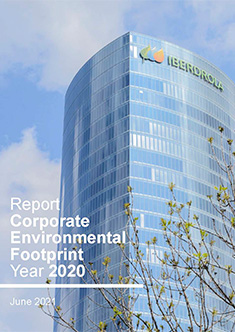Corporate Environmental Footprint (CEF)
Iberdrola, first organisation to receive the AENOR certificate for our Environmental Footprint
Business Corporate social responsibility Renewable energy
True to our commitment to transparency, every year we publish our Ecological Footprint (CEF), a summary of the Group's environmental performance. External and independent verification by AENOR accredits that we have calculated and identified all the environmental impacts derived from our activities in all the countries in which we are present, with the aim of improving and reducing them.
The Corporate Environmental Footprint (CEF) is defined as a multi-criteria measure of the environmental performance of an organisation that provides goods or services, with the perspective of the whole life cycle, i.e. considering not only direct impacts but also indirect impacts on which we have influence, for example through our suppliers. The overall objective of an CEF is to seek to reduce the environmental impact derived from the organisation's activities.
Objectives of the Corporate Environmental Footprint
 Analysis life cycle Identify impacts
Analysis life cycle Identify impactsPrioritise aspects
 Single indicator Single methodology
Single indicator Single methodologyMeasure to improve
 TransparencyCommunication with Stakeholders Benchmarking
TransparencyCommunication with Stakeholders Benchmarking
The Iberdrola Group's Environmental Footprint objectives are:
- Understand and compare objectively the effect of our activity in the different environmental impact categories, trace their cause, identifying the environmental aspects and the assets/technologies/regions responsible of them. This will be an extra element of information for the company's management system.
- Have a single homogeneous methodology for the whole Group that measure to improve. Development of environmental impact reduction activities to increase operational efficiency and corporate reputation, through transparency; drive innovation and internal and external benchmarking; and mitigate environmental risks.
- Ensure the Group's commitment to transparency.
Main environmental impacts observed
-
Terrestrial acidification
-
Particulate matter formation
-
Water use
-
Climate change
-
Photochemical ozone formation
-
Human toxicity
-
Ionising radiation
-
Transformation of rural land
-
Use of natural resources
-
Eutrophication: freshwater and seawater
-
Urban and rural land occupancy
-
Use of fossil fuels
-
Destruction of the ozone layer
-
Ecotoxicity: soil, freshwater and seawater

 SEE INFOGRAPHIC: Main environmental impacts observed [PDF]
SEE INFOGRAPHIC: Main environmental impacts observed [PDF]
The calculation of the Endpoint provides us with a final value for the company's global environmental performance by grouping the different environmental impacts into a single score. In turn, the Endpoint score values for each impact category are also reported:
| Impact category | Score (Points) |
|---|---|
| Climate change (Human health) | 2,462,985,143 |
| Ozone layer depletion | 263,150 |
| Human toxicity | 208,219,643 |
| Photochemical ozone formation | 124,216 |
| Particulate matter formation | 400,279,430 |
| Ionising radiation | 7,512,979 |
| Climate change (Ecosystems) | 207,421,492 |
| Soil acidification | 308,613 |
| Freshwater eutrophication | 119,281 |
| Soil ecotoxicity | 313,296 |
| Freshwater ecotoxicity | 741,320 |
| Marine ecotoxicity | 124,606 |
| Rural land occupancy | 14,700,327 |
| Urban land occupancy | 90,808,939 |
| Natural land transformation | 18,340,081 |
| Mineral resource depletion | 98,977,114 |
| Fossil fuel depletion | 3,037,657,389 |
| Iberdrola Group environmental footprint | 6,548,897,020 |
Data at the end of 2023. Information extracted from the "Environmental Footprint Report 2023".
Our Environmental Management System
To respond to international expansion and the diversity of our activities that have an environmental impact, the Iberdrola group Environmental Management System was designed in 2008 to create a common environmental framework to coordinate different group plans and measures, while at the same time respecting the independence and features of each region.
This model establishes a common line for strategies and policies, defines compliance report criteria and standards, and lays down a set of monitoring KPIs.
The summary of our performance in 2016 was certified for the first time by AENOR Enlace externo, se abre en ventana nueva. , in accordance with the international technical specification ISO/TS 14072 on Environmental Management –Life Cycle Assessment– Requirements and guidelines for organisational life cycle assessment. Obtaining this certificate is part of the Group's commitment to the UN Sustainable Development Goals, especially number 7 —Affordable and clean energy— and number 13 —Climate action.
Enlace externo, se abre en ventana nueva. , in accordance with the international technical specification ISO/TS 14072 on Environmental Management –Life Cycle Assessment– Requirements and guidelines for organisational life cycle assessment. Obtaining this certificate is part of the Group's commitment to the UN Sustainable Development Goals, especially number 7 —Affordable and clean energy— and number 13 —Climate action.
The aim of this verification by a renowned, independent third party is to objectively ensure the accuracy and integrity of the information published. To award this certificate, AENOR has observed 18 environmental impacts over the course of 2016, as well as our behaviour with respect to climate change, the depletion of fossil fuels and by-products of water consumption, among others.
Previous Corporate Environmental Footprint reports
We compiled the inventory of previous years' Corporate Environmental Footprint reports, a comprehensive document published annually in which we identify all the environmental impacts arising from our activities.

Carbon footprint
What is the carbon footprint and why will reducing it help to combat climate change?

Committed to the SDGs
The 17 SDGs that make up the 2030 Agenda seek to achieve a sustainable future.

Policy on Nature
Respect for the environment is key to our sustainable energy model

Indexes and data of sustainability
Analysis of Iberdrola's economic, environmental and social performance.






















